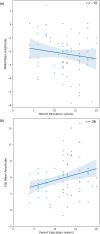Childhood family socioeconomic status is linked to adult brain electrophysiology
- PMID: 39163384
- PMCID: PMC11335154
- DOI: 10.1371/journal.pone.0307406
Childhood family socioeconomic status is linked to adult brain electrophysiology
Abstract
A large body of research has linked childhood family socioeconomic status (SES) to neurodevelopment in childhood and adolescence. However, it remains unclear to what extent childhood family SES relates to brain functioning in adulthood. To address this gap, the present study investigated the associations between retrospective accounts of objective and subjective childhood family SES and two well-established electrophysiological indices of brain functioning in adulthood-the MMN and P3b event-related potentials (ERP) components, as neural correlates of automatic change detection and cognitive control respectively. Higher objective childhood family SES, as proxied by parent educational attainment in childhood, was associated with larger (more positive) P3b amplitudes in adulthood. In contrast, there was no association between childhood parent educational attainment and the magnitude of MMN. Adult reports of subjective family SES during childhood were not related to the magnitude of MMN or P3b. These findings suggest that the links between childhood parent educational attainment and brain functioning may extend into adulthood, especially for brain functions supporting cognitive control. These results also imply that, when using retrospective accounts of childhood family SES, objective and subjective reports likely proxy different childhood experiences that have distinct links with specific neurodevelopmental outcomes, and that some of these links may not persist into adulthood. Our findings lay the groundwork for future investigations on how and why childhood family SES relates to brain functioning in adulthood.
Copyright: © 2024 Isbell et al. This is an open access article distributed under the terms of the Creative Commons Attribution License, which permits unrestricted use, distribution, and reproduction in any medium, provided the original author and source are credited.
Conflict of interest statement
The authors have declared that no competing interests exist.
Figures




References
-
- Kim P, Evans GW, Chen E, Miller G, Seeman T. How socioeconomic disadvantages get under the skin and into the brain to influence health development across the lifespan. In: Halfon N, Forrest CB, Lerner RM, Faustman EM, editors. Handbook of Life Course Health Development. Cham (CH): Springer; 2017. - PubMed
-
- Diemer MA, Mistry RS, Wadsworth ME, López I, Reimers F. Best practices in conceptualizing and measuring social class in psychological research. Anal Soc Issues Public Policy. 2013. Dec;13(1):77–113.
MeSH terms
LinkOut - more resources
Full Text Sources
Miscellaneous

